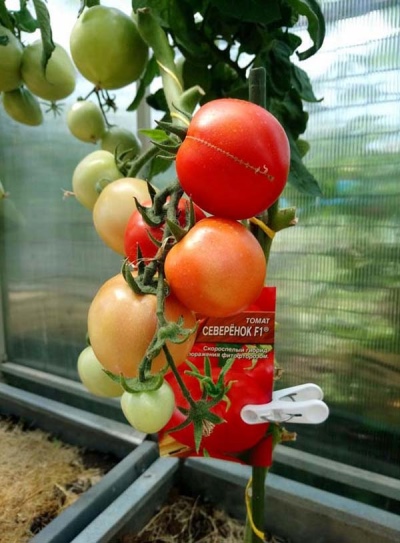
- Authors: Kachainik V.G., Chernaya V.V. (Agrofirma Aelita LLC)
- Year of approval: 2008
- Category: hybrid
- Growth type: determinant
- Appointment: fresh consumption, for pickling and preserving
- Ripening period: ultra early
- Ripening time, days: 85-90
- Growing conditions: for open ground, for film greenhouses
- Transportability: high
- Bush size: undersized
Many summer residents like to grow early varieties of tomatoes on the site, which already at the end of June delight with a bountiful harvest. Hybrid ultra-early tomatoes, including Severenok, are in great demand.
Breeding history
The Severenok hybrid was developed by Russian scientists Kachainik and Chernaya in 2006. In 2008, the culture appeared in the ranks of the State Register of Breeding Achievements of Russia, and was also approved for use. Tomato is grown in greenhouses and in garden beds in all regions of the country - North-West, Central, Far Eastern, Ural, North Caucasian, East Siberian, Central Black Earth.
Description of the variety
Tomato Severenok is a low-growing plant of the determinant type, growing up to 60-70 cm in height. In greenhouses, the bush grows up to 80-100 cm. The plant has an average foliage with light green foliage, a strong central stem, a developed root system that feeds the bush, and simple inflorescences. The first cluster with fruits is formed above 4-5 leaves, where from 5 to 8 berries are tied.
When growing, tomato bushes need to be formed in 2-3 stems and partial pinching. Despite the short stature, it is worth tying up the branches of the bushes, since they can break off under the weight of the tomatoes. The purpose of tomatoes is universal, so they are eaten fresh, canned, processed, pickled. The variety is ideal for whole-fruit canning, which captivates housewives.
The main qualities of the fruit
Tomato Severenok is a representative of medium-fruited Solanaceae. On average, the berry weighs 108 grams. The vegetable is characterized by a flat-round shape with a noticeable ribbing of the surface at the stalk. In a state of technical maturity, the vegetable is painted in a pale green color, and when ripe, it is evenly covered with a rich red color. The tomato skin is glossy and firm, but not tough. Tomato is resistant to cracking, tolerates transportation well and can be stored for a long time in a cool place.
Taste characteristics
The taste of the vegetable is excellent. The flesh of the fruit is fleshy, moderately firm, quite juicy and with few seeds. The palate traces a balance of acidity and sweetness, complemented by a spicy aroma that not all hybrid varieties can boast of. In the section of a tomato, 3 seed chambers are observed, and there are no voids at all.
Ripening and fruiting
The Severenok variety belongs to the ultra-early category. From the moment of mass germination of seedlings until the appearance of ripe berries on the bushes, only 85-90 days pass. Tomatoes ripen quickly, so you can remove them with whole brushes. The period of maximum yield of tomatoes falls on July-August. The fruiting period may shift slightly due to the climatic features of the growing area.
Yield
The tomato belongs to the high-yielding species of nightshade. Subject to all recommendations on agricultural technology, up to 5 kg of ripe tomatoes can be harvested from 1 m2 per season. In a greenhouse, the yield can be up to 20% higher.
The timing of planting seedlings and planting in the ground
Sowing seeds is carried out from the end of March to the first decade of April, that is, 55-60 days before transplanting. Beforehand, the seedlings are sorted out and disinfected in a solution of potassium permanganate. Seed germination occurs on the 5-7th day. To speed up the emergence of sprouts, you can cover the boxes with plastic or glass.For seedlings to grow, you should provide warmth (22-25 degrees) and a lot of light in the room. At the stage of the appearance of 2 leaves, you can dive. A week before the transfer, the seedlings are hardened by exposing them to fresh air daily.
It is worth planting bushes at the stage of appearance of 5-7 leaves and a hardened root. In the open ground, the bushes are transplanted in early June, and in the greenhouse 2 weeks earlier.

Growing tomato seedlings is an extremely important process, because it largely depends on whether the gardener will be able to harvest at all. All aspects must be taken into account, from seedbed preparation to planting in the ground.
Landing scheme
In addition to agricultural technology, it is worth observing the density of placement and the scheme of planting a vegetable crop, which will provide air and light access to each bush. There are no more than 3-4 seedling bushes per 1 m2. The correct layout for planting is 50x40 cm.

Growing and care
Tomatoes love breathable soil with neutral acidity. The culture grows well on the site where zucchini, carrots or cucumbers were previously grown. The site should be well lit by the sun.
In addition to the right place, it is worth providing the tomatoes with comprehensive care: watering, applying useful fertilizers, forming and tying plants, loosening the soil, protecting against pests and fungal diseases. In greenhouses, it is recommended to control the humidity level by periodically ventilating them.




A plant needs different micronutrients at each stage of growth. All fertilizers can be divided into two groups: mineral and organic. Folk remedies are often used: iodine, yeast, bird droppings, eggshells.
It is important to observe the rate and period of feeding. This also applies to folk remedies and organic fertilizers.
Disease and pest resistance
Plant immunity is high, so tomatoes practically do not undergo fusarium wilt, tobacco mosaic virus and phytophthora.


Resistant to adverse weather conditions
Good stress resistance allows the crop to bear fruit stably even in unfavorable conditions - during drought, heat and temperature fluctuations.

























































































